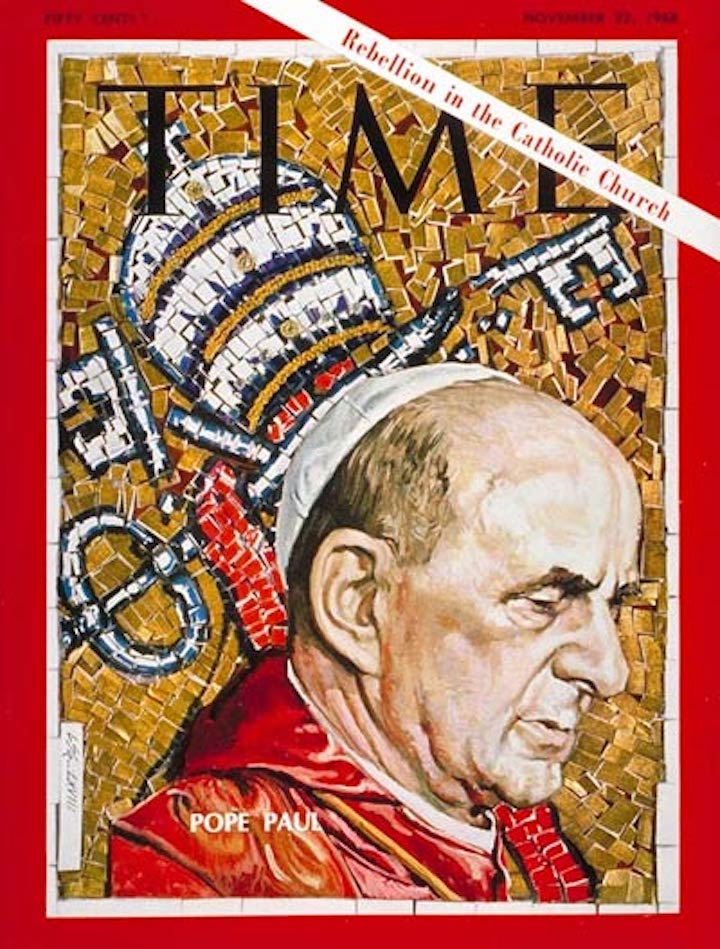To hear some people talk, one would get the impression that the Church’s prohibition against artificial contraception, as reaffirmed in Paul VI’s encyclical Humanae Vitae (1968) came out of the blue. In fact, there’s a strong and consistent ban on all such practices from the earliest days of the Church, right into the twentieth century, with statements to the same effect by Pope Paul VI’s three immediate predecessors, as well as Vatican II’s Gaudium et Spes. And all the Protestant Reformers held to this teaching, as did all their spiritual descendants, until the beginning of the twentieth century.
Pope John Paul II restated that case for the teaching of Humanae Vitae with patience and regularity. Two statements of his, however, are particularly noteworthy. In 1983, he declared: “Contraception is to be judged so profoundly unlawful as never to be, for any reason, justified. To think or to say the contrary is equal to maintaining that in human life, situations may arise in which it is lawful not to recognize God as God.” (L’Osservatore Romano, October 10, 1983)
In 1987, he again asserted that “the Church’s teaching on contraception does not belong to the category of matter open to free discussion among theologians, Teaching the contrary amounts to leading the moral consciences of spouses into error.” (L’Osservatore Romano, July 6, 1987)
Yet more than 80 percent of U.S. Catholic women of child-bearing age ignore this teaching. So why bother to “beat a dead horse”?
Because the truth of the Gospel and the truth about the human person are at stake.
Often even people of goodwill find the logic of Humanae Vitae difficult to understand. They know the Magisterial teaching but feel it has no grounding in Scripture.
One passage (which provides a basic theme for the whole of the Bible) is instructive about the plan of God and the response He expects from those who would wish to be numbered among His Chosen People. I refer specifically to:
This is my covenant with you and your descendants after you that you must keep: every male among you shall be circumcised. Circumcise the flesh of your foreskin, and that shall be the mark of the covenant between you and me. Throughout the ages every male among you when he is eight days old, shall be circumcised, including household slaves and those acquired with money from any foreigner who is part of your blood. Yes, both the house born slaves and those acquired with money must be circumcised. Thus my covenant shall be in your flesh as an everlasting pact. (Genesis 17:10-13)
As God began to form a people uniquely His own, He established a covenant with Abraham as the father of that chosen nation. The Lord promised that Abraham’s descendants would be as numerous as “the stars of the sky and the sands of the seashore.” (Genesis 22:17) And that from a man who was “as good as dead.” (Hebrews 11:12)
All this showed that the Lord was God, both in love and in power; He was truly Yahweh (I Am Who Am), who thus revealed himself to Moses as the very source of life. (Exodus 3:14)

When Abraham asked God to demonstrate His love, God spoke in terms of life; ever since, love and life have been inextricably linked to each other, for they are two sides of the same coin.
In ancient times, covenants were the normal means of doing business, and such agreements always had external signs. The Lord said the sign for Abraham and every son of the covenant thereafter was to be that of circumcision.
How strange! Why not a sign that would be visible to all at every moment? Why a sign seen only by the man and his wife? For a reason so simple that is most profound: the act of sexual intercourse would thenceforth speak not only the language of love but equally the language of life, which is to say, that sexual intimacy would speak God’s language.
Therefore, every time a Hebrew man engaged in intercourse, he would be reminded that this particular act had been invested with a new meaning by God himself, a point literally branded into one’s flesh and as enduring as God’s will, God’s love, God’s gift of life.
The connection between love and life reaches its apex in Jesus Christ, who loves humanity so much that He gives His life that “we might have life and have it to the full.” (John 10:10) Like His heavenly Father, Jesus offers a covenantal sign of His love in the lifeblood of the Eucharist, that new and everlasting covenant.
Christians need not practice circumcision under the new covenant, but they are still called to reflect those same values in who we are and what we do, an example provided in a preeminent manner by Christ’s sacrifice of himself on our behalf.
Unlike any faith system before or since, the covenant way of the Lord sacralizes human sexuality by making it a mirror image of God’s own gifts of himself as Love and Life. Therefore, we deal here with the truth of God’s identity and man’s dignity at one and the same time.
No wonder, then, that St. Paul could rhapsodize on the beauty of marital love as a great mystery, indeed the sign of Christ’s love for His Church. Contraceptive intercourse, on the other hand, lies about both the God of the covenant and the children of the covenant.
Decades after Humanae Vitae the Church holds to this essential teaching with a tenacity that annoys and astounds most people (even in the Pope Francis era), but she does so because of fundamental convictions that underlie the whole vocation of being a part of the Chosen People.
__________















